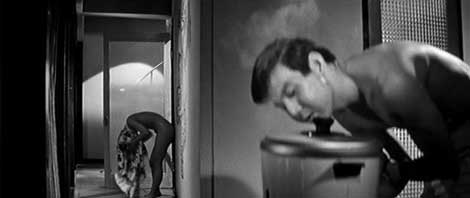There’s something wonderful about the idea that one of Japan’s most avant-garde films was originally intended to be a second feature for a double bill from a studio that was famous for cranking out formulaic Yakuza B movies. Seijun Suzuki began his stint at Nikkatsu studio in 1956, where he was assigned to the second tier unit to crank out low budget gangster movies. There were advantages to working in this department. The studio heads were less prone to interfering in low budget films that made back their investments, and Suzuki’s films were meant to fill screening schedules. By 1963 he was developing a reputation as an auteur, and so began his clashes with the studio heads. Between 1963 and 1967 he cranked out 14 films. These comprise the bulk of what people consider his golden period, and most Suzuki retrospectives focus on these films. All of his Criterion titles are from this period.
In a 1997 interview in conjunction with a festival of this work, Suzuki seemed bemused by his elevated status. As he explains, he had no special passion that drove him to make films. It was a way to make a living, and he learned his craft as an assistant director. His goal was to take the dull and formulaic scripts and to make them entertaining. He is better known to many now in Japan as a beloved actor.
His last color film in 1966 was Tokyo Drifter. In the rather formulaic script, a Yakuza killer wants to leave the business, but gets dragged back into Yakuza activities. To this script he added elements of American westerns, MGM musicals and lit the whole thing with a color palette straight out of Disneyland’s Small World. (The building where the final shootout takes place looks like the ride without the singing dolls). That ending is available on YouTube, and is well worth watching as a stand alone moment of Gonzo.
Hoping to bring him back under control, his next films were set to be shot on even tinier budgets in black and white. In response, he released the bats. Branded to Kill (1967) is derived from a formulaic script. The script is treated like a melody that a jazz musician is riffing on. There are a series of killers who are all numbered (shades of The Prisoner, which dated from the same time). Killer #3 (the movie’s lead) has the unscripted quirk of only being able to achieve sexual arousal when he smells rice boiling. After a series of hit jobs that go well, our protagonist accidently kills the wrong person when a butterfly lands on his rifle. (One can safely assume that the butterfly wasn’t in the script) There is an ongoing cat-and-mouse scenario where Number One and our hero (Number Three) engage in a prolonged series of sieges and shoot-outs that are filmed in the manner of German Expressionism. The whole thing ends in an empty boxing ring in a darkened hall in an empty arena. Despite being under a contract, he was fired for this film and was blackballed from Japanese cinema for 10 years. Once he was able to make films again, he never quite recovered the momentum of those early days. Happily he is now a revered figure, as he enters his tenth decade.


